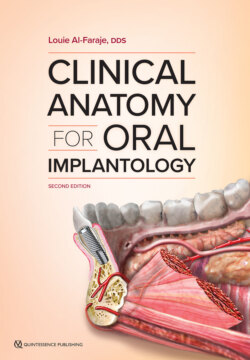Читать книгу Clinical Anatomy for Oral Implantology - Louie Al-Faraje - Страница 11
На сайте Литреса книга снята с продажи.
Maxillary Artery
ОглавлениеThe maxillary artery (Fig 1-3) arises in the parotid gland as a terminal branch of the external carotid artery. The branches of the maxillary artery can be divided into three parts:
FIG 1-3 The course of the maxillary artery. a.—artery; aa.—arteries.
Part I or the mandibular part (located within the substance of the parotid gland and anterior to the external acoustic meatus): In this part, the maxillary artery gives branches to the ear, the dura, the temporomandibular joint, the mandibular teeth, and the mylohyoid muscle.
Part II or the pterygoid part (located in the infratemporal fossa): The branches here are mainly to the muscles of mastication, the buccal mucosa and skin, and the buccinator muscles through the buccal artery.
Part III or the pterygopalatine part (the branches in the pterygopalatine fossa after entry through the pterygomaxillary fissure): The branches here are mainly to the hard and soft palate through the branches of the descending palatine artery, to the maxillary molars and premolars through the posterior superior alveolar artery, to the upper pharynx and tympanic cavity through the artery of the pterygoid canal, to the nasopharynx and sphenoidal sinus through the pharyngeal artery, and to the maxillary anterior teeth through the infraorbital artery.
The maxillary artery terminates as the sphenopalatine artery on the nasal septum after splitting into nasal branches. Figure 1-4 demonstrates in detail the branches of all three parts of the maxillary artery.
FIG 1-4 The distribution of all three parts of the maxillary artery. a.—artery.
